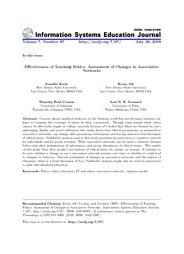Volume 7
Volume 7, Number 87 |
July 29, 2009 |
Abstract: Concern about unethical behavior in the business world has moved many business colleges to examine the coverage of ethics in their coursework. Though some people think ethics cannot be effectively taught in college curricula because of a belief that ethics are formed by one’s upbringing, family and social influences, this study shows that ethical perceptions, as measured in associative networks, can change after presenting information and having instructor-led discussion of ethical issues. Pathfinder analysis used in this study generates an associative or cognitive network for individuals and for group averages. These associative networks can be used to measure changes before and after presentation of information and group discussions of ethical issues. The results of this study show that people’s perceptions of ethical issues do change on average. It remains to be seen whether a change in one’s associative network persists over time or whether it could lead to changes in behavior. Beyond assessment of changes in associative networks and the impact of education, there is a brief discussion of how Pathfinder analyses might also be used by instructors to plan individualized education.
Keywords: Ethics, ethics education, IT and ethics, associative network, cognitive model
Download this issue: ISEDJ.7(87).Kreie.pdf (Adobe PDF, 10 pages, 691 K bytes)
Preview the contents: Kreie.j.txt (ASCII txt, 20 K bytes)
Recommended Citation: Kreie, Alt, Cronan, and Leonard (2009). Effectiveness of Teaching Ethics: Assessment of Changes in Associative Networks. Information Systems Education Journal, 7 (87). http://isedj.org/7/87/. ISSN: 1545-679X. (A preliminary version appears in The Proceedings of ISECON 2008: §2723. ISSN: 1542-7382.)
